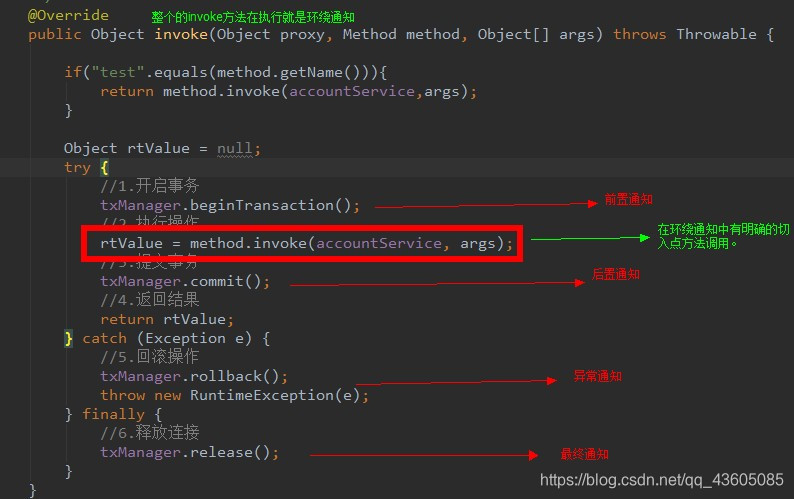一、AOP 与 Spring中的AOP
- AOP 概述
AOP:全称是 Aspect Oriented Programming 即:面向切面编程。

简单的说它就是把我们程序重复的代码抽取出来,在需要执行的时候,使用动态代理的技术,在不修改源码的基础上,对我们的已有方法进行增强。
2.AOP 的作用及优势
作用:
在程序运行期间,不修改源码对已有方法进行增强。
优势:
(1)减少重复代码
(2)提高开发效率
(3)维护方便
3.AOP 的实现方式
使用动态代理技术来把我们程序重复的代码抽取出来,对已有方法进行增强。
例如:动态代理实现事务的控制(Spring(4))
二、Spring中的AOC
我们学习 spring 的 aop,就是通过统一配置的方式,实现程序重复的代码抽取出来。
通过是否实现接口来决定是 基于接口的动态代理(至少实现一个接口) 与 基于子类的动态代理(被代理类不能是最终类)
1.AOP 相关术语
(1)第一组
Joinpoint( 连接点):所谓连接点是指那些被拦截到的点。在 spring 中,这些点指的是方法,因为 spring 只支持方法类型的连接点。即业务层接口所有的方法。
Pointcut( 切入点):所谓切入点是指我们要对哪些 Joinpoint 进行拦截(加强)的定义。
例如:在创建service代理对象的factory中,test()没有被加强
所以对于业务层接口中,void test(); //它只是连接点,不是切入点,因为没有被增强,而其他的findAllAccount()等,则既是连接点也是切入点(被加强过的点)
public IAccountService getAccountService() {
return (IAccountService) Proxy.newProxyInstance(accountService.getClass().getClassLoader(),
accountService.getClass().getInterfaces(),
new InvocationHandler() {
@Override
public Object invoke(Object proxy, Method method, Object[] args) throws Throwable {
Object returnValue = null;
if("test".equals(method.getName())) {
return method.invoke(accountService, args);
}
.....
}
|
public interface IAccountService {
List<Account> findAllAccount();
void transfer(String souceName,String targetName,Float money);
void test();
}
|
(2)第二组
Advice( 通知/ 增强):所谓通知是指拦截到 Joinpoint 之后所要做的事情就是通知。
例如:在创建代理对象的factory中,添加事务控制即是通知(增强)
Introduction( 引介):引介是一种特殊的通知在不修改类代码的前提下, Introduction 可以在运行期为类动态地添加一些方
法或 Field。
@Override
public Object invoke(Object proxy, Method method, Object[] args) throws Throwable {
Object returnValue = null;
if("test".equals(method.getName())) {
return method.invoke(accountService, args);
}
try {
transactionManager.beginTransaction();
returnValue = method.invoke(accountService, args);
transactionManager.commit();
return returnValue;
} catch (Exception e) {
transactionManager.rollback();
throw new RuntimeException(e);
} finally {
transactionManager.release();
}
}
|
通知的类型:前置通知,后置通知,异常通知,最终通知,环绕通知。
例如:事务控制中
(3)第三组
1.Target( 目标对象):代理的目标对象。
2.Weaving( 织入):是指把增强应用到目标对象来创建新的代理对象的过程。
spring 采用动态代理织入,而 AspectJ 采用编译期织入和类装载期织入。
3.Proxy (代理):一个类被 AOP 织入增强后,就产生一个结果代理类。即由getAccountService()返回的增强后的代理类
4.Aspect( 切面):是切入点和通知(引介)的结合。即 切入点IAccountService中的方法 与 TransactionManager(通知)的结合 创建service代理对象的factoryBeanFactory
2.Spring 中的 AOP 内容
(1)开发阶段(我们做的)
编写核心业务(service)代码(开发主线):大部分程序员来做,要求熟悉业务需求。
把公用代码抽取出来,制作成通知(重复的代码/工具类)。(开发阶段最后再做):AOP 编程人员来做。
在配置文件中,声明切入点与通知间的关系,即切面。:AOP 编程人员来做。
(2)运行阶段(Spring 框架完成的)
Spring 框架监控切入点方法的执行。一旦监控到切入点方法被运行,使用代理机制,动态创建目标对象的代理对象,根据通知类别,在代理对象的对应位置,将通知对应的功能织入,完成完整的代码逻辑运行。
动态代理方式:在 spring 中,框架会根据目标类是否实现了接口来决定采用哪种动态代理的方式。
三、基于 XML 的 的 AOP 配置
我们在学习 spring 的 aop 时,采用账户转账作为示例。并且把 spring 的 ioc 也需要先一起应用进来。
1、环境搭建
(1)创建spring的配置文件并配置spring的ioc
<bean id="accountService" class="com.itheima.service.impl.AccountServiceImpl"></bean>
|
(2)抽取公共代码制作成通知
public class Logger {
public void printLog() {
System.out.println("Logger类中的printLog方法开始记录日志了...");
}
}
|
2、配置步骤
(1)把通知类用bean标签配置起来
<bean id="logger" class="com.itheima.util.Logger"></bean>
|
(2)使用aop:config声明aop配置
Spring的基于XML的AOP配置步骤
1.把通知bean也交给Spring来管理
2.使用aop:config标签表明开始AOP的配置
3.使用aop:aspect标签表明配置切面
id属性:是给切面提供一个唯一名称标识
ref属性:是指定通知类bean的id
4.在aop:aspect标签内部使用 对应的标签 来配置通知的类型
现在的示例是让其成为 前置通知 即aop:before
method属性:用于指定Logger类中哪个方法是前置通知
pointcut属性:用于指定切入点表达式,该表达式的含义指的是对业务层中哪些方法增强
代码如下:
(1)使用aop:config声明aop配置
(2)使用aop:aspect配置切面
<aop:config>
<aop:aspect id="logAdvice" ref="logger">
<aop:before method="printLog"
pointcut="execution(* *..AccountServiceImpl.saveAccount())"></aop:before>
</aop:aspect>
</aop:config>
|
(3)使用aop:pointcut配置切入点表达式
(4)使用aop:before/after/...配置对应的通知类型
<aop:config>
<aop:pointcut id="pt1" expression="execution(* com.itheima.service.impl.*.*(..))"/>
<aop:aspect id="logAdvice" ref="logger">
<aop:before method="beforePrintLog"
pointcut-ref="pt1"/>
<aop:after-returning method="afterReturningPrintLog"
pointcut-ref="pt1"/>
<aop:after-throwing method="afterThrowingPrintLog"
pointcut-ref="pt1"/>
<aop:after method="afterPrintLog"
pointcut-ref="pt1"/>
<aop:around method="aroundPrintLog"
pointcut-ref="pt1"/>
</aop:aspect>
</aop:config>
|
3、切入点表达式说明
切入点表达式的写法:
关键字:execution(表达式)
表达式:
访问修饰符 返回值 包名.包名.. ...类名.方法名(参数列表)
标准的表达式写法:
public void com.itheima.service.impl.AccountServiceImpl.saveAccount()
1.访问修饰符可以省略
2.返回值可以使用通配符,表示任意返回值
3.包名可以使用通配符,表示任意包。但是有几级包,就需要写几个*.
包名可以使用..表示当前包和子包
4.类名和方法名都可以使用*来实现通配
5.参数列表,可以直接写数据类型,引用类型写包名.类名方式
全通配写法:
* *..*.*(..)
*
实际开发中切入点表达式的通常写法:
切到业务层实现类下的所有方法
*com.itheima.service.impl.*.*(...)
4、环绕通知
环绕通知
问题:
当我们配置了环绕通知之后,切入点方法没有执行,而通知方法执行了。
分析:
通过对比动态代理中的环绕通知代码,发现动态代理的环绕通知有明确的切入点方法调用,而我们的代码中没有
解决:
Spring框架为我们提供了一个接口,ProceedingJoinPoint。该接口有一个方法proceed(),此方法就相当于明确调用切入点方法。
该接口可以作为环绕通知的方法参数,在程序执行时,Spring框架会为我们提供该接口的实现类供我们使用。
Spring中的环绕通知:
它是Spring框架为我们提供的一种可以在代码中 手动控制 增强方法何时执行的方式
配置方式: 除了在XML中配置环绕通知,还需要在切面中配置aroundPrintLog()方法
public Object aroundPrintLog(ProceedingJoinPoint pjp) {
Object returnValue = null;
try {
Object[] args = pjp.getArgs();
System.out.println("前置通知:Logger类中的方法开始记录日志了...");
returnValue = pjp.proceed();
System.out.println("后置通知:Logger类中的方法开始记录日志了...");
} catch (Throwable throwable) {
System.out.println("异常通知:Logger类中的方法开始记录日志了...");
throwable.printStackTrace();
} finally {
System.out.println("最终通知:Logger类中的方法开始记录日志了...");
return returnValue;
}
}
|
四、 基于注解的 AOP 配置
1、环境搭建
(1)需要导入context 与aop 的名称空间
<?xml version="1.0" encoding="UTF-8"?>
<beans xmlns="http://www.springframework.org/schema/beans"
xmlns:aop="http://www.springframework.org/schema/aop"
xmlns:context="http://www.springframework.org/schema/context"
xmlns:xsi="http://www.w3.org/2001/XMLSchema-instance"
xsi:schemaLocation="http://www.springframework.org/schema/beans
http://www.springframework.org/schema/beans/spring-beans.xsd
http://www.springframework.org/schema/aop
http://www.springframework.org/schema/aop/spring-aop.xsd
http://www.springframework.org/schema/context
http://www.springframework.org/schema/context/spring-context.xsd">
|
(2)配置Spring创建容器时,要扫描的包(注解配置必须)
(3)配置Spring开启注解AOP的支持
<context:component-scan base-package="com.itheima"></context:component-scan>
<aop:aspectj-autoproxy></aop:aspectj-autoproxy>
|
(4)把资源使用注解配置
@Service("accountService")
public class AccountServiceImpl implements IAccountService {
@Override
public void saveAccount() {
System.out.println("save account ...");
}
@Override
public void updateAccount(int i) {
System.out.println("update account ...");
}
@Override
public int deleteAccount() {
System.out.println("delete account ...");
return 0;
}
}
|
2、配置步骤
(1)把通知类也使用注解配置
@Component("logger")
public class Logger {
...
}
|
(2)并在通知类上使用@Aspect注解声明为切面
@Component("logger")
@Aspect
public class Logger {
}
|
(3)在增强的方法(切入点)上使用注解配置通知
**
* 用于记录日志的工具类,它里面提供公共的代码
* @author Mango
*/
@Component("logger")
@Aspect
public class Logger {
@Pointcut("execution(* com.itheima.service.impl.*.*(..))")
private void pt1() {}
@Before("pt1()")
public void beforePrintLog() {
System.out.println("前置通知:Logger类中的beforePrintLog方法开始记录日志了...");
}
@AfterReturning("pt1()")
public void afterReturningPrintLog() {
System.out.println("后置通知:Logger类中的afterReturningPrintLog方法开始记录日志了...");
}
@AfterThrowing("pt1()")
public void afterThrowingPrintLog() {
System.out.println("异常通知:Logger类中的afterThrowingPrintLog方法开始记录日志了...");
}
@After("pt1()")
public void afterPrintLog() {
System.out.println("最终通知:Logger类中的afterPrintLog方法开始记录日志了...");
}
}
|
3、切入点表达式注释
@Pointcut("execution(* com.itheima.service.impl.*.*(..))")
private void pt1() {}
@Around("pt1()")
|
4、环绕通知注解配置
@Around("pt1()")
public Object aroundPrintLog(ProceedingJoinPoint pjp) {
Object returnValue = null;
try {
Object[] args = pjp.getArgs();
System.out.println("前置通知:Logger类中的方法开始记录日志了...");
returnValue = pjp.proceed();
System.out.println("后置通知:Logger类中的方法开始记录日志了...");
} catch (Throwable throwable) {
System.out.println("异常通知:Logger类中的方法开始记录日志了...");
throwable.printStackTrace();
} finally {
System.out.println("最终通知:Logger类中的方法开始记录日志了...");
}
return returnValue;
}
|
5、纯注解方式(不使用xml)
(1)则创建一个类SpringConfiguration,将其注解成一个ConfigurationClass
@Configuration
@ComponentScan(basePackages="com.itheima")
@EnableAspectJAutoProxy
public class SpringConfiguration {
...
}
|
(2)@Bean(作用于 包中不能写注解的对象 )








